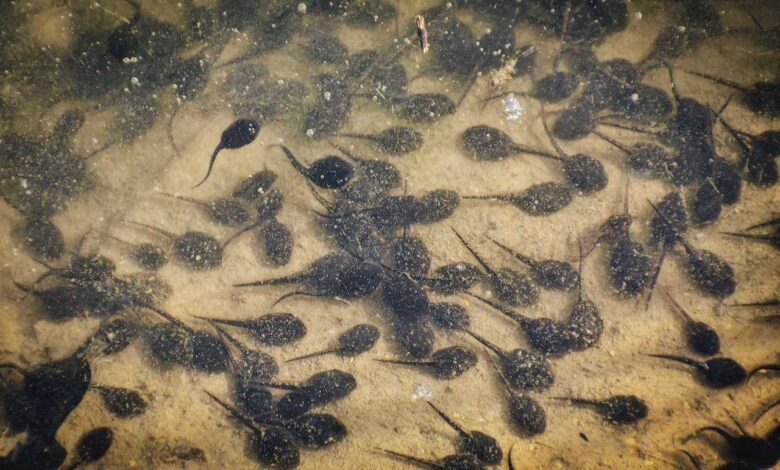Amphibian Metamorphosis: The Wonder of Amphibian Life Stages

Embark on a fascinating journey into the enchanting realm of amphibian metamorphosis. Discover the incredible transformations these creatures undergo, unraveling the mysteries of their captivating life stages.
The Wonders of Amphibian Life Stages
From Eggs to Tadpoles:
Embark on a fascinating journey into the early stages of amphibian life, exploring the miraculous transformation from eggs to tadpoles. Gain insights into the unique characteristics and behaviors displayed by amphibians during these initial phases of their development.
Life Stages Overview:
- Egg Deposition: Understanding the diverse methods of egg laying among amphibians.
- Embryonic Development: Exploring the formation and hatching of amphibian eggs.
- Tadpole Characteristics: Identifying key features of aquatic amphibian larvae.
Tadpoles and Aquatic Habitats:
Aquatic Exploration and Feeding Frenzies:
Dive into the world of tadpoles as you discover their unique behaviors and adaptations to aquatic environments. Explore the significance of water habitats for tadpole development and the intriguing ways tadpoles secure their nutrition.
Tadpole Dynamics:
- Feeding Strategies: Unraveling how tadpoles obtain nutrients in aquatic habitats.
- Swimming Patterns: Examining the locomotion and exploration of tadpoles.
- Aquatic Adaptations: Understanding physical features that aid tadpoles in water.
The Transition:
From Aquatic Larvae to Terrestrial Marvels:
Witness the marvel of metamorphosis as tadpoles undergo a profound transformation into terrestrial beings. Delve into the physiological changes, behaviors, and adaptations that accompany this transition, marking a critical phase in the life of amphibians.
Metamorphic Process:
- Physical Changes: Observing alterations in body structure and limbs.
- Behavioral Shifts: Exploring shifts in locomotion and habitat preferences.
- Adaptations for Land: Understanding features that aid in the transition to terrestrial life.
Emergence onto Land:
Exploring New Frontiers:
Embark on the terrestrial phase of amphibian life as they emerge from aquatic habitats. Understand the challenges and adjustments faced by amphibians as they transition to terrestrial living, including changes in diet, respiratory systems, and habitat preferences.
Terrestrial Adaptations:
- Dietary Shifts: Exploring new food sources and hunting techniques on land.
- Respiratory Changes: Adapting from gill-based to lung-based respiration.
- Habitat Preferences: Identifying suitable terrestrial environments.
Mating Behavior and Reproductive Strategies
Courtship Calls and Amplexus:
Uncover the fascinating world of amphibian mating rituals, courtship calls, and reproductive strategies. Explore how amphibians use various methods to attract mates, ensuring successful reproduction and the continuation of their species.
Reproductive Strategies:
- Mating Calls: Understanding the significance of vocalizations in courtship.
- Amplexus: Examining the unique embrace used by amphibians during mating.
- Egg Deposition and Parental Care: Exploring methods of egg laying and parental involvement.
Challenges and Threats in Amphibian Metamorphosis
Navigating Hazards and Conservation Concerns:
Delve into the challenges and threats that amphibians encounter during metamorphosis. Explore the impact of environmental factors, habitat loss, pollution, and climate change on amphibian populations, emphasizing the importance of conservation efforts.
Conservation Imperatives:
- Habitat Destruction: Addressing the consequences of deforestation and urbanization.
- Climate Change Effects: Examining the impact of temperature shifts on metamorphosis.
- Pollution Concerns: Understanding the dangers of water pollution and chemical contaminants.
Amphibian Metamorphosis in Different Species:
Diverse Transformations:
Embark on a comparative journey as you explore the unique metamorphic processes of different amphibian species. Contrast the timelines, adaptations, and behaviors exhibited by frogs, toads, newts, and salamanders during their metamorphic transformations.
Species-Specific Metamorphosis:
- Frog Metamorphosis: Examining the swift metamorphosis of common frog species.
- Toad Transformations: Contrasting metamorphic processes in toads.
- Newt and Salamander Metamorphosis: Exploring adaptations in these distinct amphibians.
Amphibian Metamorphosis in Captivity:
Metamorphosis Monitoring and Ethical Considerations:
Explore the responsible care and monitoring of amphibian metamorphosis in captivity. Gain insights into ethical considerations, appropriate habitats, and the role of enthusiasts and pet owners in promoting the well-being of amphibians during this critical life stage.
Captive Care Guidelines:
- Enclosure Considerations: Creating suitable habitats for metamorphosing amphibians.
- Dietary Requirements: Providing nutrition tailored to the metamorphic stage.
- Monitoring Health: Recognizing signs of stress or health issues in captive amphibians.
Celebrating the Marvels of Amphibian Transformation
From Tadpole to Terrestrial Wonder:
Conclude the exploration of amphibian metamorphosis by celebrating the magic of transformation. Whether in the wild or under the care of enthusiasts, amphibians captivate with their remarkable journey from aquatic larvae to terrestrial wonders, showcasing the wonders of nature.
FAQs: Amphibian Metamorphosis
Q1: Are there specific environmental cues that trigger amphibian metamorphosis?
A1: Environmental factors such as temperature, water availability, and photoperiod can influence the initiation of metamorphosis in amphibians.
Q2: How long does the metamorphic process typically take for common frog species?
A2: The duration of metamorphosis varies but often ranges from a few weeks to several months, depending on the species and environmental conditions.
Q3: Can amphibians experience stress during metamorphosis, and how can it be minimized in captivity?
A3: Yes, stress can impact metamorphosing amphibians. In captivity, providing a stable environment, appropriate nutrition, and minimizing disturbances can help reduce stress.
Q4: Are there conservation programs focused on protecting amphibians during metamorphosis?
A4: Conservation efforts often encompass the entire life cycle of amphibians, including metamorphosis. Programs may involve habitat preservation, captive breeding, and education to safeguard amphibian populations.
Q5: How can individuals contribute to amphibian conservation during metamorphosis?
A5: Supporting conservation organizations, participating in habitat restoration projects, and advocating for responsible environmental practices are effective ways to contribute to amphibian conservation.






